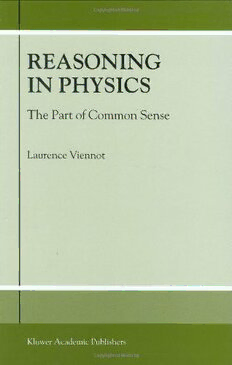
Reasoning in physics : the part of common sense PDF
Preview Reasoning in physics : the part of common sense
Reasoning in Physics This page intentionally left blank Reasoning in Physics The Part of Common Sense by Laurence Viennot Université Denis Diderot (Paris 7), France KLUWER ACADEMIC PUBLISHERS NEW YORK,BOSTON, DORDRECHT, LONDON, MOSCOW eBookISBN: 0-306-47636-3 Print ISBN: 0-7923-7140-2 ©2004 Kluwer Academic Publishers NewYork, Boston, Dordrecht, London, Moscow Print ©2001 Kluwer Academic Publishers Dordrecht All rights reserved No part of this eBook maybe reproducedor transmitted inanyform or byanymeans,electronic, mechanical, recording, or otherwise, without written consent from the Publisher Created in the United States of America Visit Kluwer Online at: http://kluweronline.com and Kluwer's eBookstoreat: http://ebooks.kluweronline.com Table of Contents ACKNOWLEDGMENTS ix ABOUT THE AUTHOR xi PREFACE xiii INTRODUCTION 1 PART ONE - THE MAIN LINES 5 CHAPTER 1 /Physics: what is essential, whatis natural? 7 1. The Essential: abstraction and coherence 7 2. Common Ways of Thinking in Physics 8 3. Taking “WrongIdeas” Seriously 9 4. Areas ofPhysics and Units ofCommon Knowledge: 10 do they coincide? 5. WhatTo Do in Teaching? 11 CHAPTER 2 / A Trend in Reasoning: materialising the objects of physics 15 1. The Essential in Physics: constructed concepts 15 2. CommonForms ofReasoninginElementaryOptics 16 3. Conclusion 34 APPENDIX 1. Research in Didactics and the New French Syllabus: Convergences 36 APPENDIX2. Excerptfromthe AccompanyingDocumentforthe French Syllabus at Grade 8, implementedin 1993 42 CHAPTER 3 / TheReal World: intrinsic quantities 47 1. The Essential: defining a frame ofreference 47 2. Questions: fishes,parachutistsandmovingwalkways 49 3. When Drag Disappears… 52 4. ConsideringNonIntrinsicQuantities: ateachinggoal 57 vi Table of Contents CHAPTER4/TheEssential: lawsforquantities “at time t” 61 1. Introduction 61 2. Analysingthe Motion ofMaterial Objects: usual ways ofreasoning 62 3. AnInterpretationofCommonWays ofReasoningin Dynamics 68 4. Coherence and Range ofCommonWays ofReasoning in 70 Dynamics 5. The Stakes inTeaching Dynamics 78 APPENDIX 1. ACauseSituatedin thePast: propulsion by aspring 80 APPENDIX2. WhenthePastLeaves its Mark 82 APPENDIX3. AnalysingInteractions: twosituations 86 APPENDIX4. ExcerptsfromOfficialInstructions ontheCurriculum ForGrades9and 11 (ScienceSection) 88 CHAPTER5/Quasistatic or Causal Changes in Systems 93 1. TheEssential: systemsthatobey simplelaws 93 2. NaturalReasoning: morestories 95 3. Systems withaClear Spatial Structure 95 4. Systems with No Clear Spatial Structure: examples from thermodynamics 105 5. LinearCausal ReasoningandQuasistatic Approaches: irremediabledifferences 114 PARTTWO - THE IMPACTOFCOMMON SENSE SOME INVESTIGATIONS 119 CHAPTER 6/Quantities, Laws andSign Conventions 121 1. Introduction 2. TheEssential: algebraicquantities andlaws 121 3. The Natural: realityfirst,lawsmust adapt 123 4. Results ofInquiries 124 5. RealisticBalances 126 6. ASuggested Strategy: splitdiagrams 128 7. VerbalStatements: confusionandmisunderstandings 129 8. Conclusion 131 Table of Contents vii CHAPTER7/Changing Frames of Reference at Eleven 133 1. Introduction 133 2. TheExperiments: principleanddescription 133 3. Main Results andDiscussion 136 4. Conclusion 138 CHAPTER 8 / CommonReasoning About Sound 141 1. Introduction 141 2. Propagation ofSignals in Secondary Teaching 141 3. MainResearchFindingsaboutPulses onRopes 143 4. Propagation ofa Sound Signal 145 5. Conclusion 150 CHAPTER 9/Constants andFunctionalReduction 153 1. Introduction 153 2. Numerical orFunctionalConstants 154 3. TheDifficulty ofExpressingNon-Dependences 159 4. Conclusion 161 CHAPTER 10/Rotationand Translation:simultaneity? 163 1. Introduction 163 2. TheInquiry: questionsandresults 165 3. Discussion and Suggestions 169 CHAPTER 11/From Electrostatics toElectrodynamics: historical andpresentdifficulties 173 1. Incompleteness ofan Analysis CentredontheTerminals ofthe Generator 174 2. History oftheConceptoftheElectricCircuit 175 3. TheReasoning ofStudents Today 180 4. Confusions between Charge andPotential 184 5. Conclusion 185 CHAPTER12/Superpositionof Electric Fields and Causality 191 1. Introduction 191 2. “Field Only ifMobility”? Questionnaires on insulators 195 3. CauseintheFormula:the Questionnaire 201 4. Summary andPedagogical Perspectives 206 viii Table of Contents CONCLUSION 209 BIBLIOGRAPHY 215 SUBJECT INDEX 225 NAME INDEX 229 Acknowledgments This work is the result of a long-term group effort, to which also contributed, in our many discussions, Ahmed Fawaz and more recently, Martine Méheut and Gérard Rebmann. My sincere thanks to them. The support and interest of my Physics colleagues at the Université Denis Diderothave alsoproved essential. I am indebted to the pupils, students, teachers and university professors withoutwhom the investigations on which this book is based would not have beenpossible. I am grateful to Michel Viennot whose careful and demanding study of this book provided me with the views of a non-specialist with a good knowledge ofscience. The translation ofthis work was carried out under excellent conditions thanks to the competence and kindness ofAmélieMoisy. And Robin Millar, who read the English version over completely, has been of invaluable aid. Mywarmestappreciationtothemboth. ix
